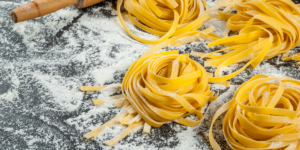What if I told you that culinary is an art? Would you agree? Just like the different palette colors combine to create the most captivating painting, various ingredients with different flavors can be mixed to create the most delicious meal.
Taste perception is, however, also influenced by the human senses. Here’s how your sense of sight, smell, and feeling influence your perception of a meal.
Food color
One thing that many fast food franchises have hacked is the effect of colors on food perception. Red, yellow, and orange are commonly used colors because they stimulate appetite.
Children rarely eat vegetables of their own accord because they believe anything green is yucky and not nice. However, for adults, the color green may give the impression of a healthy meal.
Foods that have brighter colors create a perception of a richer taste. When you cook, use fresh vegetables and fruits. The colors of fresh foods are still very bright and contribute to the appearance of the meal, as well as its palatability.

Food aroma
The nose, ear, and mouth are connected. That’s why, sometimes, when you use an ear drop, you can taste it in your mouth. Or when you inhale a perfume too deeply, it starts to feel like you can taste it.
This phenomenon can affect food palatability. The older you get, the more your sense of smell declines. This is why older people tend to add more salt to their food than younger people. Your ability to stimulate a person’s olfaction with the aroma of your food increases its appeal.
For this reason, spices like parsley, cilantro, or curry are added to foods. They impact your meal with an aroma that screams “delicious”. Without knowing how it tastes, a bowl of vegetable salad would be less interesting than a plate of jollof rice, just because of the aroma.
Food texture
The texture of a meal is not always up to the chef to decide. Most times, the food gets the same texture that the ingredients have. However, it cannot be overlooked that this is a major influence on a person’s food choice.
Why do people prefer crisp toast or pastries? It’s all in the texture. The texture of such foods improves the meal’s flavor and gives it a satisfying mouthfeel. Crunchy vegetables also give the impression of freshness and who doesn’t like to eat fresh food?
Food made the same way may sometimes be boring to the person eating it. But adjusting its texture can deepen the flavors and bring a delightful twist to any meal.
A granola bar may be boring when eaten alone, and yogurt likewise. However, mixing the two to make a parfait creates a new snack that creates a yummy contrast by combining smooth and crunchy textures.
Here’s a cooking tip: To make the most delectable guacamole, a generous amount of pureed avocado is a must.

Food presentation
Have you ever been at an event, seen how the food was served, and automatically thought to yourself that you would not be eating there? The presentation of a meal matters just as much as the taste. Food is perceived to taste better when it is presented attractively.
People visit expensive restaurants not because they have tasted the food somewhere but because of the images they see on social media. Although this has nothing to do with enhancing the flavor of the food, the plating technique gives them the idea that the food there must be great. A typical example is strawberries. Because it looks good, you assume it tastes good. The assumption proves to be fallacious, though.
Nevertheless, well-presented food stimulates appetite and builds anticipation of the flavors present.

Food and flavor combinations
Like nachos and game night or spaghetti and meatballs, some combinations are just a match made in heaven.
The right use of certain ingredients could take your meal from zero to a hundred. You can create sumptuous recipes and delicious meals by having the right understanding of flavor profiles and combinations. Individual ingredients combine to give new and unique flavors to meals.
As a rule of thumb, sweet and savory foods make a good combination. Salted caramel is one of the best potato chips or buttermilk fried chicken dips. It also goes well with cinnamon rolls and fruits. Just dice up the fruits–apples, bananas, or mangoes–and mix them with a proportional amount of salted caramel. This makes a tasty base for a fruit parfait.
Sometimes, you’re cooking a pot of soup, and you can taste the seasoning in it, but it still doesn’t taste right. With a little salt added it begins to taste better. The logic behind this is that salt is a flavor enhancer. So when it is mixed with foods like caramel, it deepens the flavor, making it more delightful to your taste buds. And when this mixture is added to any meal, it enriches the flavor of that meal.
Some other ingredients are added to a meal not necessarily to enhance the flavor of that meal but to create a flavor contrast. Oregano leaves, for example, are sprinkled on pasta, pizza, or even rice. Their slightly spicy and pungent taste gives a tasty kick to even the blandest of meals, and they generally go well with savory foods.
Oregano also helps to balance the bold flavors of onions or garlic with those of the other ingredients.

Feel free to experiment with other flavor combinations. Some other possible flavor profiles that can be combined to give you a delicious taste experience include:
- Spicy and sweet, like in Korean chili flakes (gochugaru),
- Spicy and sour, like in kimchi
- Bitter and sweet, like coffee and cream
- Salty and sweet, like chocolate-flavored pretzels
Tasty meals all come down to a proper combination of different flavor profiles. Getting the right texture, color, and aroma and presenting it well also increases the appeal of your meal.











